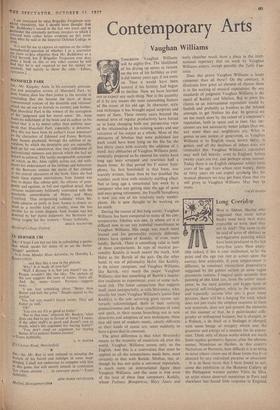Long Corridor
WAS it Aldous. Huxley who suggested that most travel books must have been mork: enjoyable to write than they are to read? -The same could be said of acres of abstract or non-figurative painting which have been produced in the last forty-five years. How enjoy- able indeed, if this is your inclination, to let the paint and the ego run riot in action upon the canvas; • how enjoyable, if your temperament is different, to construct immaculate propositiois suggested by the golden section or some vague platonistic notions. • I suggeit quite seriously that painting of this kind can, from the artists' stand- point, be the most painless and happy form of pictorial self.indulgence, while to the spectator., and especially anyone who Fees a great many. pictures, there will be a longing for work which does not just make the simplest response to form and materials, does not just present the demerits of this manner or that, be it paint-loaded calli- graphy or orthogonal balance, but is charged, as a Pollock, a de Stael or a Soulages is charged, with some -Image or imagery which uses the grammar and energy of a manner for its expres- sion. Think only of those works which are made from regalar geometric figures; after the obvious names, Mondrian or Herbin, in this country Nicholson or Pasmore, how difficult it is to bring to mind others whose use of these forms has b-..:11 directed by any individual purpose or obsession': It is in these terms that I have found so wel- come the exhibition at the Hanover Gallery of the Portuguese woman painter Viera da Silva. an artist whose deserved reputation in Paris and elsewhere has found little response in England. She was born in 1908 and with her work in sight it is surprising to discover that her masters were Despiau and Bourdelle, Friesz and Leger. Her departure from their characteristic art is one in- dication of her very positive personality and in- tentions. Beneath an abstract appearance the pictures present two kinds and levels of content. There are the allusions to and derivations from the visible world as suggested by the titles—the -village, the port of Rotterdam, the zoo. At a deeper and more significant level there is a per- sistent theme which can be seen most obviously in the earliest of the paintings here, one called Couloir sans Linzites. Imagine an endless corridor -whose walls, floor and ceiling are made, not of a solid substance, but of some fragile material like net which moves, creases and folds and . is set with mosaic-like rectangles of colour. Calmly and with no sense of vertigo the eye travels down the passage exploring its surfaces and facets. This formal theme, this deep and complex recession,
dominates Viera da Silva's art in the way that so much of Jacques Villon's painting is built upon the pyramid of central perspective. It is as if she was voluntarily confined to one window upon the world but that the view from it was suffering con- stant and profound transformations of mood, activity, action and population.
The pictures are given their command by this compulsive theme, one which also gives relevance to her pictorial method with its quiet taches act- ing within a nervous linear framework. In con- sequence she does not paint according to some orthodoxy but works to uncover this central image with all its implications and connections. There is in these pictures an exceptional balance of rms.' culine rigour and decisiveness and feminine sensibility. She must be placed not simply as one of the finest women artists of this century in any medium but one of the most interesting abstract painters of the present.
BASIL TAYLOR



































 Previous page
Previous page